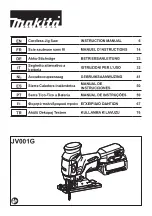
14
Cutting
Place the wider portion of the saw shoe on that part of the workpiece which is solidly
supported, not on the section that will fall off when the cut is made. As an example,
Figure 10 illustrates the RIGHT way to cut off the end of a board. Always clamp
work. Don’t try to hold short pieces by hand! Remember to support cantilevered and
overhanging material. Use caution when sawing material from below.
Be sure saw is up to full speed before blade contacts material to be cut. Starting saw with
blade against material to be cut or pushed forward into kerf can result in kickback. Push
the saw forward at a speed which allows the blade to cut without laboring.
Hardness and toughness can vary even in the same piece of material, and knotty or damp
sections can put a heavy load on the saw. When this happens, push the saw more slowly,
but hard enough to keep working without much decrease in speed. Forcing the saw can
cause rough cuts, inaccuracy, kickback, and over-heating of the motor.
Should your cut begin to go off the line, don’t try to force it back on. Release the trigger
switch and allow blade to come to a complete stop. Then you can withdraw the saw, sight
anew, and start a new cut slightly inside the wrong one. Withdraw the saw if you must
shift the cut. Forcing a correction inside the cut can stall the saw and lead to kickback.
IF SAW STALLS, RELEASE THE TRIGGER SWITCH AND BACK THE SAW UNTIL IT IS
LOOSE. BE SURE BLADE IS STRAIGHT IN THE CUT AND CLEAR OF THE CUTTING
EDGE BEFORE RESTARTING.
As you finish a cut, release the trigger switch and allow the blade to stop before lifting
the saw from the work. As you lift the saw, the spring-tensioned lower blade guard
will automatically close under the blade. Remember the blade is exposed until this
occurs. Never reach under the work for any reason. When you have to retract the
lower blade guard manually (as is necessary for starting pocket cuts), always use
the retracting lever.
WARNING:
When cutting thin strips, be careful to ensure that small cutoff pieces
don’t hang up on the inside of the lower blade guard.
RIPPING (FIG. 13)
Ripping is the process of cutting wider boards into narrower strips – cutting grain
lengthwise. Hand guiding is more difficult for this type of sawing and the use of a
D
E
WALT CS390FNC rip fence is recommended.
INSTALL RIP FENCE
IN THIS DIRECTION
FIG. 13
POCKET CUTTING (FIG. 14)
WARNING:
Never tie the lower blade guard in a raised position. Never move the
saw backwards when pocket cutting. This may cause the saw to raise up off the work
surface, which could cause injury.
A pocket cut is one that is made in a floor, wall or other flat surface.
1. Adjust the saw shoe so the blade cuts at desired depth.
2. Tilt the saw forward and rest front of the shoe on material to be cut.
3. Using the lower blade guard retracting lever, retract the lower blade guard to an
upward position. Lower the rear of the shoe until the blade teeth almost touch the
cutting line.
4. Release the lower blade guard
FIG. 14
(its contact with the work will
keep it in position to open freely
as you start the cut). Remove
your hand from the lower blade
guard retracting lever and firmly
grip the auxiliary handle, as
shown in Figure 14. Position your
body and arm to allow you to
resist kickback if it occurs.
5. Make sure blade is not in contact
with cutting surface before
starting saw.
Summary of Contents for DCS391-XE
Page 1: ...DCS391 XE DCS393 XE 18 V CORDLESS 165 mm 6 1 2 CIRCULAR SAW INSTRUCTION MANUAL ...
Page 18: ......
Page 19: ......





































